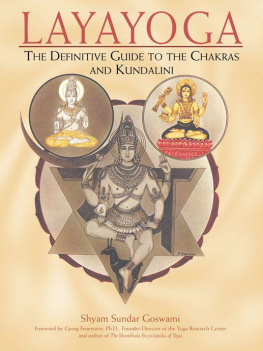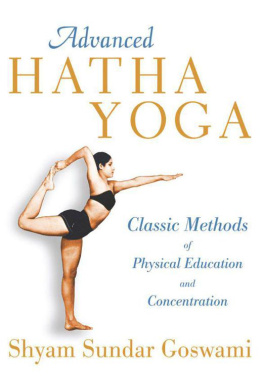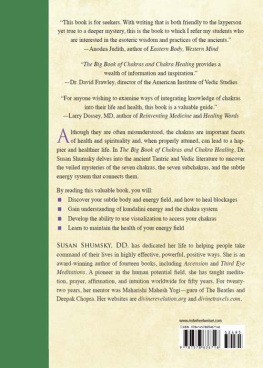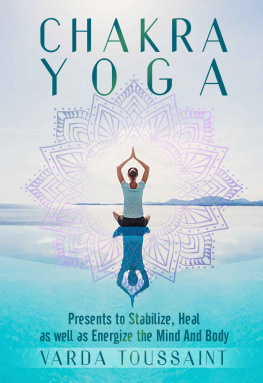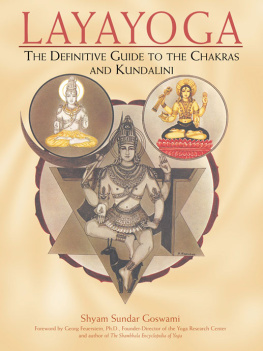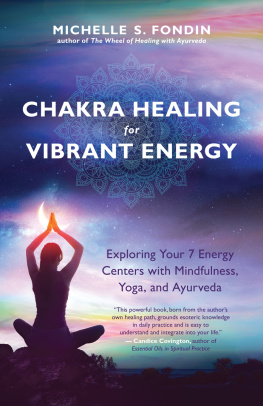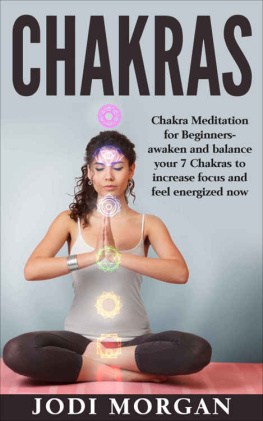LAYAYOGA
T HE D EFINITIVE G UIDE TO THE C HAKRAS AND K UNDALINI

Shyam Sundar Goswami

Inner Traditions
Rochester, Vermont
To Wani
Goddess of Words
uttishthata jagrata prapya waran nibodhata
Kathopanishad, 1. 3. 14
Arise, awake and seek a teacher;
First know Who art Thou.
This Upanishadic saying reverberates in
the Greek maxim
engraved in the temple of Apollo at Delphi.
Acknowledgments
First, I wish to thank the great authority on the Weda, Acharyya Karunamoya Saraswati, Calcutta, for his kindness to write a foreword to this work.
The Plates have been taken by Mr Leif Persson, Grsmark, Sweden.
I wish to thank them all.
Shyam Sundar Goswami
Contents
)
)
)
Illustrations
between pages 12 and 13 |
I |
II |
III |
IV |
V |
between pages 144 and 145 |
|
|
|
|
|
|
|
|
|
|
|
|
|
|
|
|
|
|
|
|
|
|
|
|
|
|
|
|
Foreword to the Second Edition
by Georg Feuerstein, Ph.D.
Founder-Director of the Yoga Research Center
and author of The Shambhala Encyclopedia of Yoga
This unique volume focuses on one of the most recondite aspects of Tantra: the esoteric process by which the ordinary human body is transmuted into a divine body (divya-deha) . In such a body, every cell is suffused with consciousness, and it is endowed with extraordinary capacities (siddhi) .
At the heart of Tantra is Kundaliniyoga, and at the core of Kundaliniyoga is Layayoga. Tantra, or Tantrism, is a spiritual tradition that crystallized in the opening centuries of the first millennium C.E. and reached its zenith around 1000 C.E. It represents a remarkable synthesis and understands itself as the teaching for the present age of darkness (kali-yuga) . Among its central tenets is the notion that the body is not, as taught by more ascetical schools, an obstacle on the path to enlightenment. Rather, it is a manifestation of the ultimate Reality and hence must be fully integrated into ones spiritual aspirations. The early Tantric adepts (siddha) developed an approach that is body-positive and epitomized in the concept of body cultivation, or kaya-sadhana , which in due course led to the creation of Hathayoga with its many purificatory practices (sadhana) , postures (asana) , and techniques of breath control (pranayama) .
The purpose of these practices is not merely to acquire physical fitness and mental health, but primarily to awaken the bodys dormant psychospiritual power called kundalini-shakti. When this power, which is a form of conscious energy, is fully aroused it begins to transform the body. It leads to the ecstatic realization of ones true identity as the pure, universal consciousness (cit), and it also progressively renders the body transparent to that supreme consciousness.
This alchemical process of transmutation of the very constituents of the body is the domain of Layayoga. Laya refers to the absorption of the elements ( tattva ) constituting the body, which occurs when the kundalini power rises from the psychoenergetic center ( cakra ) at the base of the spine toward the center at the crown of the head. In its ascent along the spinal axis, it must pierce a series of psychoenergetic centers, each of which relates to specific psychosomatic functions and also anatomical structures. As it passes through each center, the kundalini absorbs each centers elements and correlated function. This induces a deepening state of mental concentration and conscious lucidity, but at the same time decreases physical animation. Thus the outside observer would notice a drastic decrease in metabolism and spontaneous suspension of breathing. In a way, the ascent of the kundalini amounts to a consciously undergone death process.
If the yogin remains long enough in this state of suspended animation, the body simply dies. But this is not the intended outcome of Tantra. Rather, the successful practitioner of Tantrayoga must next skillfully guide the kundalini from the crown center back to its home at the base of the spine. This restores all the bodily functions, yet brings a new element into play: the gradual suffusion of the body with consciousness. For the Tantric adept, enlightenment is nothing unless it includes the body. Thus the delicate process of Layayoga is designed to bring enlightenment down to earth, into the bodya quite literally breathtaking adventure.
Shyam Sundar Goswami, who was an adept of Layayoga, sifted through no fewer than 282 Sanskrit texts to gather all the relevant information about the process of absorption ( laya-krama ) into one volume. This book is a testimony to his spiritual stature and tremendous scholarship, but also to the yogic heritage of India. Nowhere else on earth can one find such profound knowledge about esoteric anatomy and the subtle energetic work necessary to achieve full enlightenment.
I hope this volume will help correct prevalent, especially New Age, misconceptions about the cakras and nadis. The information locked away in the Sanskrit scriptures and presented here comprehensively for the first time is based on actual yogic experimentation and realization, which makes Shyam Sundar Goswamis compilation an extremely valuable gift to genuine Yoga practitioners. I would like to commend the publisher for reissuing this book, which has been out of print for many years.
Foreword
It has been expounded in the wedamantra: yogeyoge tawastarang wajewaje hawamahe. sakhaya indramutaye (Rigweda-sanghita, 1.30.7). That is, with our hearts attuned, we worship with deepest love Indra (Supreme Power-Consciousness) so as to be able to practise samprjata yoga (with all its parts successfully, by removing all obstacles that distract the mind), and then (by developing supreme unaffectedness) asamprajata yoga.
This worship is ishwarapranidhana, that is, concentration in deepest love for God. Love-concentration causes samadhi. Patajali has also said: ishwarapranidhanad wa (samadhi is also attained by love-concentration on God) (Yogasutra, 1.23) and samadhisiddhi rishwarapranidhanat (the accomplishment of samadhi is effected by love-concentration on God) ( ibid ., 2.45).
There are Oupanishada explanations of the Waidika yogeyoge. It has been stated: yogena yogo jatawyo yogo yogat prawardhate (Soubhagyalakshmyupanishad, 2.1). That is, yoga is to be known by yoga, and yoga develops from yoga. This means that the attainment of asamprajata yoga is accomplished by samprajata yoga; asamprajata yoga develops from samprajata yoga. Again, yogena yogang sangrodhya... ( ibid ., 2.12). That is, controlling yoga by yoga. This means that samprajata yoga is controlled by asamprajata yoga. In other words, samprajata samadhi is transformed into asamprajata samadhi when control develops to its highest degree.
The nonappearance of the absorbed writtis (linawritti) is the limit of control (Adhyatmopanishad, 42). At this stage, natural mental absorption, leading to mind-transcendent state, occurs (Akshyupanishad, 2.3).
Yoga means samadhi. So it has been stated: sa gha no yoga a bhuwat... (Rigwedasanghita, 1.5.3), that is, the yoga is established in yoga. Here, yoga is samadhi.
Next page
